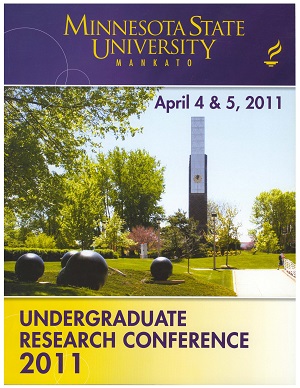Algal Filtration for Excess Nutrient Removal
Location
CSU 253/4/5
Start Date
4-4-2011 1:30 PM
End Date
4-4-2011 3:00 PM
Student's Major
Mechanical and Civil Engineering
Student's College
Science, Engineering and Technology
Mentor's Name
Stephen Druschel
Mentor's Department
Mechanical and Civil Engineering
Mentor's College
Science, Engineering and Technology
Description
The purpose of this research is to determine the effects of filtration procedures on algal blooms and excess phosphorus in Minnesotan Lakes. The use of algal filtration could benefit lakes by removing excess nutrients that contribute to algal blooms. This project is directed at the Lake Elysian Community; however the results can be used for other communities. Fertilizers containing phosphorus and nitrogen are used in the fields surrounding Lake Elysian to enhance the growth of crops. During rainfall, excess fertilizers are washed into the lake creating more nutrients for algal bacteria to grow.
Three sterile plastic tubs were used to create an aquarium version of a lake by using water and silt from Lake Elysian. These tubs were used to grow algae and replicate lakes with algal blooms. Three different filters were used in this experiment. Two methods were used by acknowledging the American Society for Testing and Materials Standards. These included procedures of using sieved sand to capture the algae and phosphorous. The third method was a membrane filtration process aimed singly at catching the algal bacteria. Tests were done before and after each filtration testing phosphorous levels, total suspended solids, turbidity, and a microscopic test of what bacteria still remained.
It is expected that the filtering of the water will reduce the amount of algae and phosphorous in the water. After we have finished this experiment, we hope that our ideas in filtering can help communities throughout Minnesota in lake management.
Algal Filtration for Excess Nutrient Removal
CSU 253/4/5
The purpose of this research is to determine the effects of filtration procedures on algal blooms and excess phosphorus in Minnesotan Lakes. The use of algal filtration could benefit lakes by removing excess nutrients that contribute to algal blooms. This project is directed at the Lake Elysian Community; however the results can be used for other communities. Fertilizers containing phosphorus and nitrogen are used in the fields surrounding Lake Elysian to enhance the growth of crops. During rainfall, excess fertilizers are washed into the lake creating more nutrients for algal bacteria to grow.
Three sterile plastic tubs were used to create an aquarium version of a lake by using water and silt from Lake Elysian. These tubs were used to grow algae and replicate lakes with algal blooms. Three different filters were used in this experiment. Two methods were used by acknowledging the American Society for Testing and Materials Standards. These included procedures of using sieved sand to capture the algae and phosphorous. The third method was a membrane filtration process aimed singly at catching the algal bacteria. Tests were done before and after each filtration testing phosphorous levels, total suspended solids, turbidity, and a microscopic test of what bacteria still remained.
It is expected that the filtering of the water will reduce the amount of algae and phosphorous in the water. After we have finished this experiment, we hope that our ideas in filtering can help communities throughout Minnesota in lake management.
Recommended Citation
Origer, Mark; Anthony Adams; Kyle Bruender; Sriya Panta; and Kristopher Roppe. "Algal Filtration for Excess Nutrient Removal." Undergraduate Research Symposium, Mankato, MN, April 4, 2011.
https://cornerstone.lib.mnsu.edu/urs/2011/poster-session-C/27



